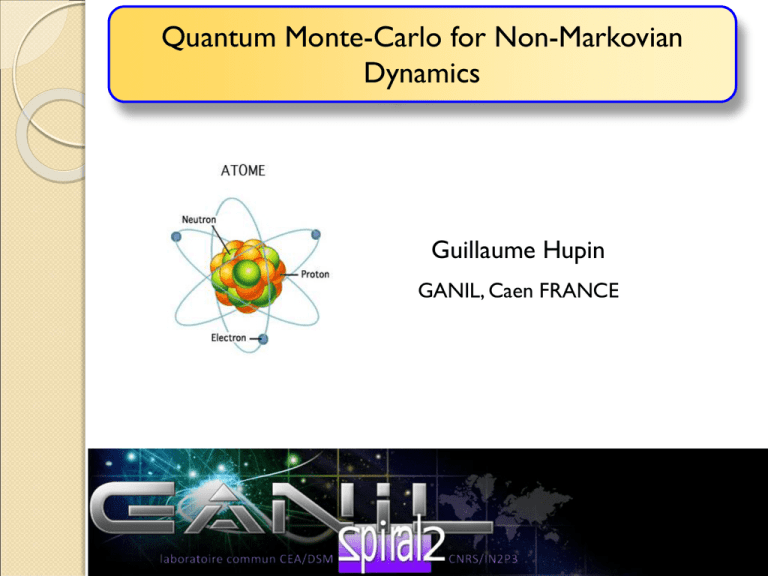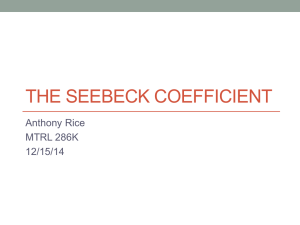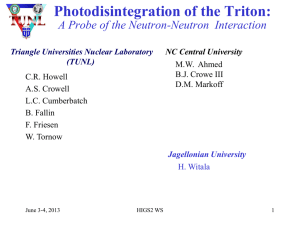Quantum Monte-Carlo for Non-Markovian dynamics
advertisement

Quantum Monte-Carlo for Non-Markovian Dynamics Guillaume Hupin GANIL, Caen FRANCE Collaborator : Denis Lacroix Overview 1. Motivation in nuclear physics : Fission and Fusion. 2. Non-Markovian effects : Projective methods. 3. Quantum Monte-Carlo. System Environment 4. Applications : A. To the spin-star model. B. To the spin-boson model. C. In the Caldeira Leggett model. Physics case : fission H. Goutte, J. F. Berger, P. Casoli, Phys. Rev. C 71 (2005) Environment Nucleons System: and potential Environment: Nucleons (intrinsic) motion Coupling: response thermal bath. Fast motion fission decay. —› Markovian vs Physical case : fusion Different channels are opened in a fusion reaction : Relative distance. Environment System : relative distance. Environment : nucleon motion, other degrees of freedom (deformation…). => Non-Markovian effects are expected. Microscopic evolution can be mapped to an open quantum system. K.Washiyama et al., Phys. Rev. C 79, (2009) Motivations Environment Q Q Non-Markovian. Markovian. Framework The total Hamiltonian written as (S) is the system of interest coupled to (E). (E) is considered as a general environment. Exact Liouville equation. von Neumann The environment has too many degrees of freedom. Standard approaches : projective methods Exact evolution System System only evolution I = interaction picture Therefore, use projective methods to “get rid” of (E). First, define two projection operators on (S) and (E). Project the Liouville equation on the two subspace. System Environment Standard approaches : projective methods The equation of motion of the system is closed up to a given order in interaction. H. Breuer and F. Petruccione, The Theory of Open Quantum Systems (Oxford University Press, Oxford, 2002) Nakajima-Zwanzig’s method (NZ). s t Time non local method : mixes order of perturbation. (NZ2, NZ4..) Time Convolution Less method (TCL). s t Time local method : order of the perturbation under control. (TCL2,TCL4 …) Comparison between projective techniques In the CaldeiraLeggett model: an harmonic oscillator coupled to a heat bath. Q Using a Drude spectral density: Exact NZ2 NZ4 Exact TCL2 (perturbation) TCL4 TCL4 is in any case a more accurate method. G.Hupin and D. Lacroix, Phys. Rev. C 81, (2010) New approach : Quantum Monte Carlo The exact dynamics is replaced by a number of stochastic paths to simulate the exact evolution in average. D is complicated : The environment has too many degrees of freedom. Noise designed to account for the coupling. t0 t Theoretical framework Exact Liouville von Neumann equation. Other stat. moments are equal to 0. Stochastic Master Equations (SME). D. Lacroix, Phys. Rev. E 77, (2008) Theoretical framework : proof SME Proof : Using our Stochastic Master Equations. SME has its equivalent Stochastic Schrödinger Equation Deterministic evolution Stochastic Schrödinger equation (SSE): … Leads to the equivalence : L.Diosi and W.T. Strunz Phys. Lett. A 255 (1997) M.B. Plenio and P.L. Knight, Rev. Mod. Phys. 70 (1998) J.Piilo et al., PRL 100 (2008) A. Bassi and L. Ferialdi PRL 103 (2009), Among many others….. Independence of the statistical moments : Application of the SSE to spin star model Statistical fluctuation : A Monte-Carlo simulation is exact only when the statistical convergence is reached. 1000 Trajectories Noise optimized. Including the mean field solution Take the separable : density as Then, take the Ehrenfest evolution : Position & momentum : ok Width : not ok Mean field + QMC D. Lacroix, Phys. Rev. A 72, (2005) Evolution of the statistical fluctuation have been reduced using an optimized deterministic part in the SME. Projected Quantum Monte-Carlo + Mean-Field Exact evolution The environment response is contained in : System Stochastic trajectories Link with the Feynman path integral formalism J.T. Stockburger and H. Grabert, Phys. Rev. Lett. 88, (2002) Application to the spin boson model This method has been applied to spin boson model. Exact (stochastic) TCL2 A two level system interacting with a boson bath Second successful test. D. Lacroix, Phys. Rev. E 77, (2008) Y. Zhou , Y. Yan and J. Shao, EPL 72 (2005) Application to the problems of interest Environment Fission/fusion processes The potential is first locally approximated by parabola. Benchmark in the Caldeira-Leggett model Second moment evolution. Q QMC. Exact. Convergence is achieved for second moments for different temperatures. with an acceptable time of calculation. with a limited number of trajectories (≈104 ). Observables of interest E Exact. Quantum Monte Carlo. Projection 2nd order in interaction. Projection 4nd order in interaction. Passing probability 2nd order in perturbation TCL Markovian approximation E Monte Carlo Accuracy of MC simulations is comparable to the fourth order of projection. 4th order in perturbation TCL Accuracy of such calculations Exact are of interest for very heavy nuclei. Summary It has been pointed out that TCL4 should be preferred. New theory based on Monte Carlo technique has been applied and tested for simple potentials. This study shows that the new method is effective. Now, the new technique Monte-Carlo+Mean-Field should be applied to more general potentials. Critical issue: diverging path Possible solutions : C. Gardiner, “A Handbook of Stochastic Remove the diverging trajectories. Methods” Semi-classic approximations : Initial Value Methods W. Koch et al. , PRL 100 (2008)







